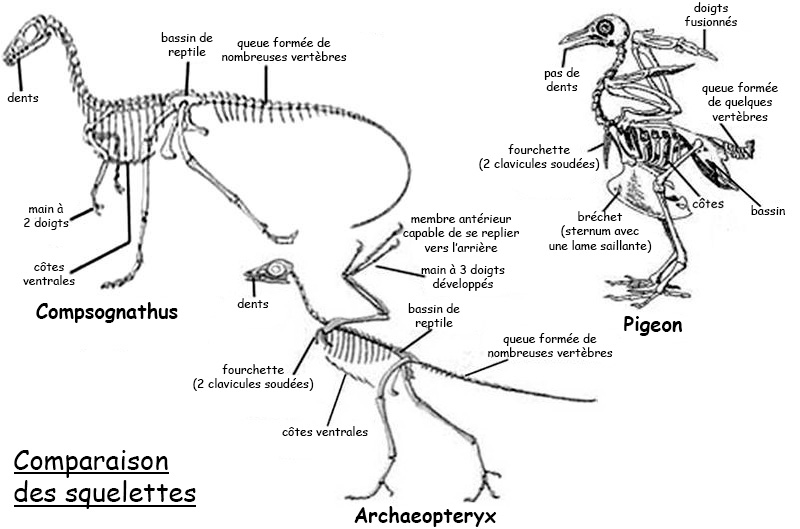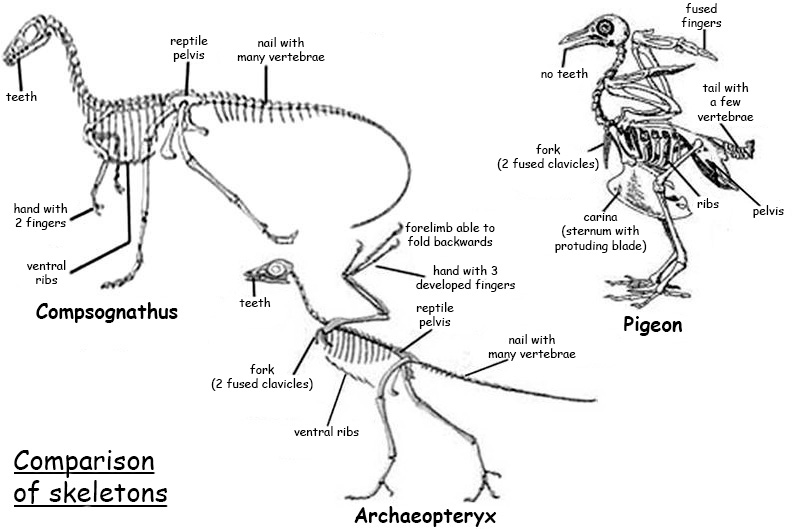
Attention, cette cache n'est accessible qu'aux horaires d'ouverture du Parc d'Isle :
- du 1er mars au 31 octobre, de 8h à 20h
- du 1er novembre 28 février, de 8h à 18h
Evolution, définition : Théorie selon laquelle les animaux et les végétaux seraient issus d'un stock restreint d'êtres vivants primitifs à partir desquels ils se seraient diversifiés. (Dictionnaire de Géologie, édition Dunod)
Cette théorie s'appuie sur la comparaison d'espèces vivantes ou fossiles (morphologie, plan d'organisation, génétique...) afin d'établir des relations de parenté entre elles, mais aussi sur la découverte de fossiles représentant des "formes intermédiaires" entre deux groupes connus, mettant en évidence les étapes de l'évolution entre deux groupes distincts. L'archaeopteryx est l'exemple le plus communément utilisé pour expliquer cette notion de forme intermédiaire.
Le degrés de parenté entre les groupes est établi à partir de l'âge estimé de la séparation des lignées à l'origine de ces deux groupes, à partir du dernier ancêtre commun (deux population de cet ancêtre ont évolué différemment, formant deux nouveaux groupes distincts). Plus la séparation est récente (donc plus le dernier ancêtre commun est récent), plus le degrés de parenté entre ces groupes est important.
La comparaison des fossiles de petits dinosaures, comme le Compsognathus, d'Archaeopteryx et d'oiseaux actuels a permis de découvrir des informations importantes concernant l'évolution des vertébrés.



La earthcache

Pour pouvoir valider cette earthcache, vous devrez répondre correctement aux questions suivantes.
Merci d’envoyer vos réponses via mon profil ou via la messagerie geocaching.com, ne les donnez pas dans votre log.
Vous pouvez loguer la cache "found it", je vous contacterai en cas de problème.
Aux coordonnées indiquées se trouve un panneau explicatif.
1) A partir de ce panneau et des informations de cette page, indiquez parmi les caractères évoqués (aspect extérieur, squelette, crâne) :
a. les caractères primitifs (de type reptile) que possède l'Archaeopteryx ;
b. ses caractères évolués (de type oiseau).
2) D'après l'arbre évolutif figurant sur le panneau, estimez l'âge (en Millions d'années) de la séparation de la branche des oiseaux de celle des dinosaures.
3) A quelle période géologique cela correspond-t-il ?
4) Quels sont les plus proches parents des dinosaures vivant encore actuellement ? Justifiez.
5) Vous pouvez également ajouter à votre log une photo de vous ou de votre gps près du panneau, devant la volière par exemple (facultatif mais grandement apprécié).

This earthcache is accessible only when the Parc is open :
- march to october, from 8:00 am to 8:00 pm
- november to february, from 8:00 am to 6:00 pm
Evolution, definition : The theory that animals and plants would be derived from a limited stock of primitive living beings from which they would have diversified. ( Geology Dictionary , Dunod edition )
This theory is based on the comparison of living or fossil species (morphology, body plan, genetics ...) to establish kinship relations between them, but also the discovery of fossils representing "transitional forms" between two known groups, highlighting the steps in the change between two distinct groups. The archeopteryx is the example most commonly used to explain the concept of intermediate form.
The degrees of relationship between groups is drawn from the estimated age of the separation of lines at the origin of these two groups, from the last common ancestor (two population this ancestor evolved differently, forming two new groups distinct). More recent separation is (thus the last common ancestor is new), the more the degrees of relationship between these groups is important.
Comparing fossils of small dinosaurs, like Compsognathus, of Archaeopteryx and modern birds has uncovered important information about the evolution of vertebrates.



The earthcache

To be able to validate this earthcache, you will have to correctly answer the following questions.
Thank you for sending your answers via my profile or the geocaching.com Message Center, don't take it in your log.
You can post your log "found it", I shall contact you in case of problem.
At the specified coordinates is an explanatory panel.
1) From this panel and information on this page, enter evoked among characters (appearance, skeleton, skull):
a. primitive characters (like reptile) that Archaeopteryx has;
b. its evolved characters (bird type).
2) According to the evolutionary tree shown on the panel, estimate age (million years) the separation of the branch of the dinosaurs to birds.
3) To what geological period is it corresponded ?
4) What are the closest relatives of dinosaurs alive today? Justify.
5) You can also add to your log a photo of you or your GPS near the panel, in front of the aviary for example (optionnal but strongly appreciated).